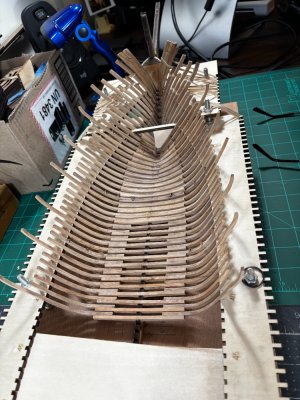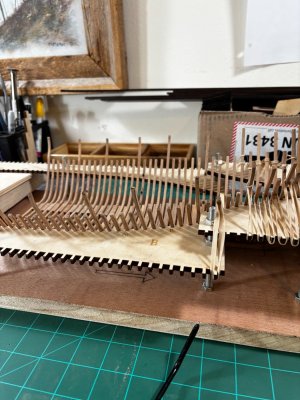- Joined
- Dec 3, 2022
- Messages
- 1,547
- Points
- 488

Thanks Jim, one milestone at a time eh!
To get that far in a month, you must be wearing seven league boots.
 |
As a way to introduce our brass coins to the community, we will raffle off a free coin during the month of August. Follow link ABOVE for instructions for entering. |
 |

Thanks Jim, one milestone at a time eh!
Ha! Not all that fast really. When I lived up North, I had a pair of five buckle arctics!To get that far in a month, you must be wearing seven league boots.
True story Daniel .At this stage tho it’s one frame at a timeThanks Jim, one milestone at a time eh!
 . Cheers Grant
. Cheers GrantMost definitely Grant. There is something about building a fairly stout structure out of sticks that is very rewarding. Even though the char is a pain in the butt, it does serve as a sanding guide along with the fairing lines.Dremel and dust… must be fun or we wouldn’t do it, right
The Dremel is definitely your friend!Not nearly as boring, tedious, or mind numbing as one might think.Applying a fast sand down with my Dremel almost to the reference lines takes out most of the char then file and sandpaper to fit. Once glued into the keel then just some minor sanding to fair out the frames, internal sanding for fairing is a bit more uncomfortable due to limited access though.
View attachment 514067
Yea I have been considering purchase of high end files. I own a cheap set and an intermediate set, both mostly unsatisfactory.a good file will leave a very smooth surface.
Yea I have been considering purchase of high end files. I own a cheap set and an intermediate set, both mostly unsatisfactory.
Great info!Dean62 said:
A good file will leave a very smooth surface.
I’d just like to expand a bit on what Dean mentioned in his posts and your reply. While a quality set of files is definitely important, smoothness on the surface isn’t guaranteed unless you're using the right cut or grade for the task. Even a top-tier file like a Vallorbe (Swiss-made) won’t yield a smooth finish if you’re using a coarse or double-cut file where a single-cut one is needed. It's all about matching the tool to the job.
The cuts or grades on sanding files (also called teeth or file patterns) have a big effect on how they treat a surface, especially on delicate model ship hulls. Here's a quick breakdown:
Single Cut:
- Appearance: One set of parallel grooves.
- Effect: Smoothest cutting; removes material slowly.
- Best For: Fine finishing, fairing subtle curves, final smoothing before planking or painting.
Double Cut:
- Appearance: Crisscross pattern with two sets of grooves.
- Effect: More aggressive; removes material faster.
- Best For: Shaping rough surfaces, reducing high spots, or working on hardwood frames/bulkheads.
Rasp Cut
- Appearance: Individual, raised teeth (more common on coarse files or rasps).
- Effect: Very aggressive; can tear up soft wood or delicate edges.
- Best For: Initial rough shaping, not typically recommended for model work unless you're sculpting.
Cross-cut Needle Files (like diamond files)
- Appearance: Uniform texture, often used in metal, but good for wood too.
- Effect: Consistent, precise cut. Great for detail work or touch-ups in small spots.
- Best For: Deck grooves, rabbet lines, tight curves, or even deadwood shaping.
Top-Recommended File Brands for Model Work: Vallorbe (Swiss Made), Grobet USA, Pferd (Germany), Corrady (Italy)
Hope this clarifies and helps

I made a decision a while back to of course fully plank the port side but on the starboard side in lieu of total exposed ribs I will fashion a large window of sorts focusing on the mid-section only. I will still end up sanding out a finish to the fairing process.The glue actually holds better on a filed surface than on a sanded surface. Something else to consider as well is adhesion if it’s a bond surface.
Indeed, it does Peter.I found fairing a hull always requires some serious eyeball and adjustment.
What is the old saying, "you get what your pay for"Yea I have been considering purchase of high end files. I own a cheap set and an intermediate set, both mostly unsatisfactory.
Nice pick. Those will serve you in the long run.Allright, I just ordered a set of 6 Grobet files Cut 2.




Except he has a bunch of frames in a box that says "Memory Foam"...Congratulations! Now on to the next step x100+ which seems to be the way of this OCD hobby!
I must say, your workbench looks downright tidy and organized compared to mine.

Thanks Jeff, My only problem is I don't remember what happened to all that memory foam!Except he has a bunch of frames in a box that says "Memory Foam"...


Check in the box marked "Frames"......Thanks Jeff, My only problem is I don't remember what happened to all that memory foam!

